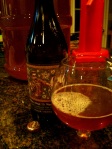 “Bottle conditioned with maple syrup” the label states. This statement actually made me hesitate previously. If anything, I do tend to find some of DogFish Head’s brews a bit too sweet, and just seeing “maple syrup”on the label made me cringe a bit. I’ve never been one to buy that “best IPA in America” tag-line either. Their 90-minute IPA is unique, no doubt, especially when compared to what “IPA” has come to mean in the US. The DFH may use “continuous hopping”, but their IPAs are not hop bombs. They are caramel malt heavy, thick, chewy, and sweet by comparison to West Coast IPAs which tend to be much more about the hops and a dry finish. Supposedly the final gravity is very high for an IPA (1.020+) which explains the thicker mouthfeel and sweetness that battles all those hops.
“Bottle conditioned with maple syrup” the label states. This statement actually made me hesitate previously. If anything, I do tend to find some of DogFish Head’s brews a bit too sweet, and just seeing “maple syrup”on the label made me cringe a bit. I’ve never been one to buy that “best IPA in America” tag-line either. Their 90-minute IPA is unique, no doubt, especially when compared to what “IPA” has come to mean in the US. The DFH may use “continuous hopping”, but their IPAs are not hop bombs. They are caramel malt heavy, thick, chewy, and sweet by comparison to West Coast IPAs which tend to be much more about the hops and a dry finish. Supposedly the final gravity is very high for an IPA (1.020+) which explains the thicker mouthfeel and sweetness that battles all those hops.
I like the 60 minute IPA once in a while just to remind myself that not all IPAs are super dry and loaded with last minute hops for aroma. I was also lucky enough to have a case of 90-minute arrive over the Christmas holiday when my brother-in-law brought it with him and left it for me. It took a while, but I got through the case… and it gave me more of an appreciation for the beer.
One other thing holding me back was the fact that the last couple of 750ml bottles I’ve tried from DFH have left me unimpressed, especially for the money. So when I saw the 75-minute IPA, which I have not had in past years, at $11, I hesitated. Is this going to be worth it? Is it just more hype? Will the maple syrup used as priming sugar to carbonate/condition in the bottle just going to add more sweetness? I had issues.
I finally gave in. I was actually in the package store hoping to find the anti-DFH IPA, Notch Brewing’s new “Left of the Dial IPA,” a low ABV take on the style. However, it hadn’t made it to the stores yet, so I was left wondering the aisles, wondering what I should try. I’m glad I made the call on the 75-minute IPA.
It’s a blend of the 60 and 90 minute versions. It’s not brewed with it’s own recipe. And to be honest, blending beer has often been looked down upon in the past. However, folks like Matt Brindleson at Firestone Walker started creating their anniversary ales just this way… brewing multiple batches and testing blend after blend until finding something amazing. Still, the F-W blends are more like wines. This is simply taking two existing recipes and blending them to create this so-called 75-minute version… plus a couple twists. They dryhop the 75 blend with whole leaf cascade hops, and then bottle condition with the maple syrup.
I poured about 1/3 of the 750 ml bottle into a snifter, it’s carbonation was soft, with very little head. The appearance and aroma brought to mind components of the two brews blended to create it. The taste also brought to mind the 60 and 90, but it’s as if the blend brought only the best qualities. Yes, it’s still sweet, but not that noticeable alcohol/malt sweetness I find in most double IPAs. I can’t say that the use of maple syrup was obvious. Again, sugar added at bottling gives any yeast still in suspension something to eat, the CO2 byproduct carbonating the beer as the bottle’s seal prevents it from escaping. In theory, that sugar gets eaten, leaving nothing behind to flavor the beer. Perhaps if I were to taste a maple syrup primed sample blindly against one using dextrose, cane sugar, or DME (dried malt extract) I may notice a difference, but with this 75-minute, I couldn’t taste anything from the maple syrup. Gimmick? Perhaps. Regardless, this blend is delicious, and I and very happy I decided to give it a shot.
The hops are there, but just not in an “in your face” way many IPAs present them. The bitterness is mild, allowing the caramel malts to be front and center. Some pine, some floral, a little grass (from the dry hopped cascades perhaps), but again, it’s subdued and mellow. I assume a fairly high mash temp for their 60 and 90 minute IPAs would contribute to the high final gravity (more residual sugars remaining in the beer, not converted to alcohol during fermentation). Mash temp, plus the Whitbread English ale yeast strain contribute to DFH’s IPA flavor profiles. The Whitbread yeast can offer a bit more fruit esters when compared to something like the California Ale yeast strain used in many American IPAs. It also tends to be a bit less attenuative, like several English ale strains, leading to slightly higher final gravities, and a maltier beer.